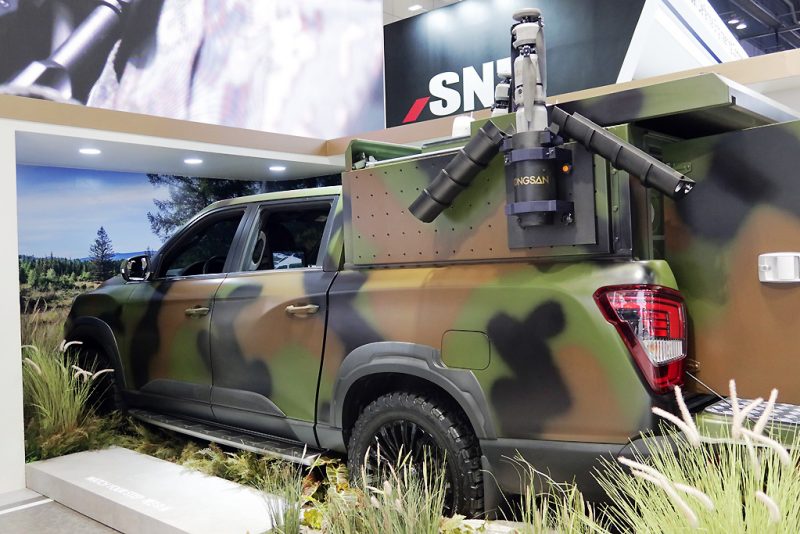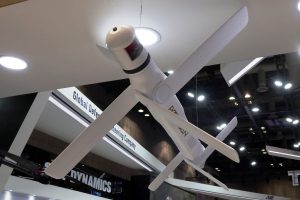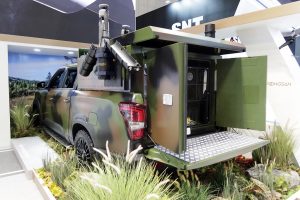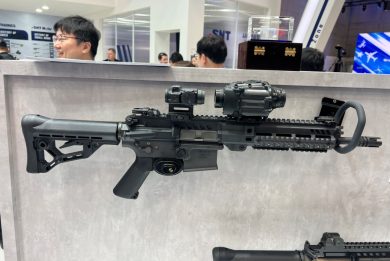ADEX 2025 – Poongsan details its MUF-1 and MUF-2 loitering munitions and unveils vehicle-mounted MCD-7
At the Seoul exhibition Poonsgan displayed its MUF-1 and MUF-2 loitering munitions, currently under development, while part of its stand was dominated by a pick-up vehicle equipped with a module carrying several Multi-Purpose Combat 7 drones, MCD-7 in short
Active in the ammunition field, Poongsan showcased its MCD concept two years ago at ADEX, alongside the Aerial Munition Attack Drone, or AMAD. In fall 2024 at MSPO the MUF, for Motor Using Fixed-wing drone, a tube-launched loitering munition, which has now become the MUF-1, as a bigger MUF-2 is being developed. The concept proposed by Poongsan sees an unmanned air vehicle loitering over the target area at altitude, receiving signals from a distant command post, relaying them to the MUFs operating at a lower flight altitude.
At take-off, the MUF-1 has a 5 kg mass and carries a 1.5 kg pre-forged-fragment high-explosive warhead, its main targets being soft skin vehicles and infantry in the open. No details were provided on dimensions, the airframe architecture being typical of tube-launched systems, with front wings hinged in the upper part of the rectangular section fuselage folding backwards, rear stabilator surfaces hinged at the bottom as well as the two vertical stabilators at the rear folding forward. The MUF-1 is fitted at the rear with an electric motor driving a two-blade pushing propeller. Just ahead of the front wing we fid the warhead, which has a circular section. Typical operating altitude is 300 meters, the MUF-1 having an endurance of 30 minutes and a range of 8 km, no details on guidance and data link being provided.
The MUF-2 has twice the mass and payload of the smaller munition, respectively 10 kg and 3 kg; intended targets are armoured vehicles, hence the warhead is of the shaped charge type. The airframe architecture differs completely from that of the MUF-1; here the cruciform wing configuration is being adopted, which ensures higher manoeuvrability in the final phase of the dive against the target, which might well operate at greater speed that those intended for the MUF-1. Once again front wings fold backwards and rear ones fold forward, propulsion being provided again by an electric motor with a two-blade propeller. Operational altitude reaches 500 meters, endurance remaining the same, but with a range of 20 km.
While the MUF-1 is clearly a man-portable system, the MUF-2, although it can be carried by a soldier, finds a better use when installed on a light vehicle, multiple munitions being then carried. EDR On-Line understood that the MUF-2 warheads are the same attack modules used on the MCD-7, namely a PFF-HE, a shaped charge and an explosively formed projectile.
The MUF-1 is in an advanced development phase, the prototype having already flown. Poongsan is preparing to bid for a ROK Army requirement, which should be issued “earlier than 2027”. As for the MUF-2, this is in an earlier development phase, its first flight being planned in early 2026.
At ADEX 2025 Poongsan also proposed its solution for a modular system to be installed at the back of a pick-up truck, to provide forces with a considerable firepower. The MCD-7 is based on a vertical take-off cylindrical airframe with two two-blade counter-rotating rotors powered by two electric motors. Its take-off mass is 7 kg, hence the MCD-7 name a much lighter MCD-2 being also available, of which 3 kg are represented by the warhead. Beside the already mentioned warheads, it can also be fitted with an ISR payload, comprising day and night sensors, a Light payload, and a communications relay payload. This gives it considerable flexibility, especially when multiple drones are available to cope with a mission, such as in the case of the vehicle mounted solution seen at the Seoul exhibition. The MCD-7 has a 30-minute endurance and a 10 km range, and can operate in swarm, the same being true also for the MUF-1 and MUF-2.
The module has a sliding roof, which moves backwards to free the eight launching tubes, two rows of four each, capable to expel with a pneumatic impulse one or more MCD-7, even when the vehicle is on the move; EDR On-Line understood that tests were conducted at a speed up to 80 km/h. On each side of the module, we could find another launcher; this is used when the vehicle is static, its upper part opening in two valves, freeing the rotors that can therefore deploy, motors activated, the system taking off under its own lift. At the back, the container module hosts two rows of five MCD-7 airframes in the two upper levels, while at the bottom we find the containers with the various warheads. Overall, the proposed solution has 20 MCD-7 on board, a considerable firepower for a light 4×4 vehicle.
Photos by P. Valpolini








